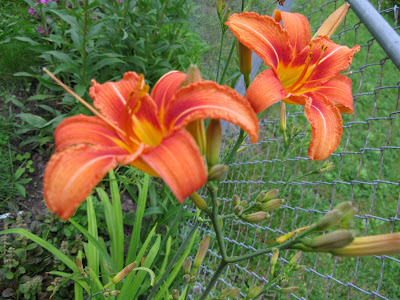

I visited Exbury Gardens in England recently and here we have the
azaleas in the magnificent gardens there. These have been around for close to
100 years and they have acres of them on display.

Azaleas growing in Exbury Gardens
Azaleas are among the most colorful of all flowering shrubs, bearing 3-6 inch clusters of red, yellow, orange, pink, white, or purple flowers in spring and early summer. Azaleas will serve most garden uses admirably, and they can also be grown in open woodlands in light shade where, they are often able to take care of themselves indefinitely. Azaleas will grow in full sun or light shade, but light shade is preferable in hot areas.

Azalea
Pictured above is one of the two azaleas in my garden.
When I purchased them last November they were small, bedraggled and near death. I talked to them, tenderly planted them in my garden and even though they only have a few blooms this season they are strong and I consider them 'survivors' - like most plants, all they need is a little attention and love. :-)

Evening Primrose - Oenothera
It seems that these came aboard in my travels from Massachusetts. They have a way of just appearing in the garden. I have never actually planted or designed an area for these flowers. They pop up around the garden and I have never removed one because they seem to place themselves in just the right location giving the border or flower bed a
delightful splash of color.
They thrive in full sun and well drained soil in Zones 4 - 9.

Geranium - Cranesbill

Cranesbill - Hardy perennial
Johnson's Blue Variety
These flowers are valuable fillers for color in early to mid summer. This long flowering hybrid forms a sprawling mound of deeply cut green foliage, bearing
large violet-blue flowers with a white eye.
Likes the sun - does well in Zones 3 - 10 - height 2'
These were also transplanted from Massachusetts to Western New York.
*****
End of June chores:
-Remove faded flowers
-Prune ground covers as needed
-Thin seedlings
-Sow seeds outdoors for succession plantings
-Keep the garden free of weeds
-Stake tall plants
-Water as needed
-Pinch annuals and perennials as needed
-Disbud roses and other flowering plants for larger blooms
-Now is the time to remove the unsightly foliage of the spring bulbs. When left intact to wither they ripen the bulbs naturally. I mow my daffodil drifts around July 4th, for example. Deadhead spring-flowering perennials unless they have showy seed heads, or you want to collect seed later (non-hybrids only).
photos by peacesojourner














































